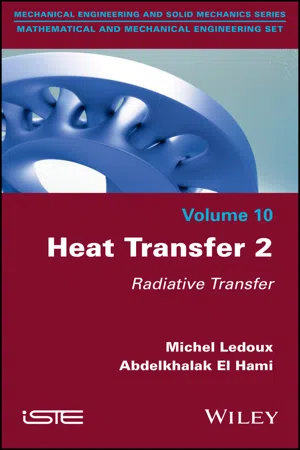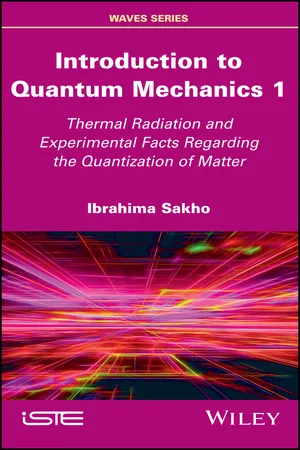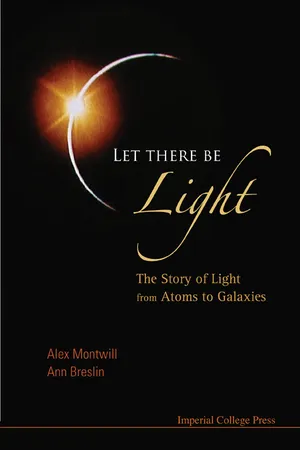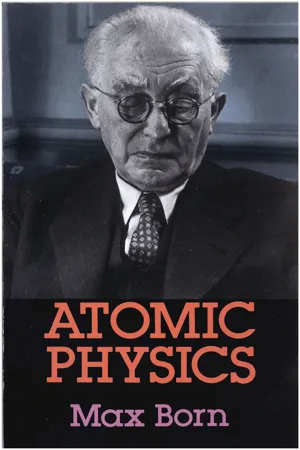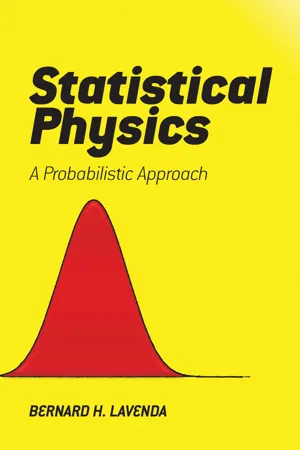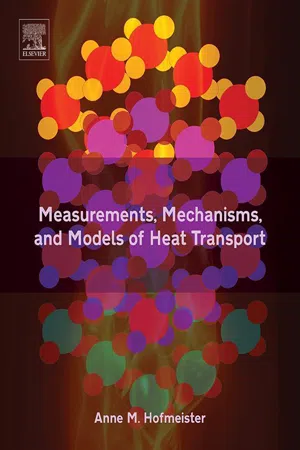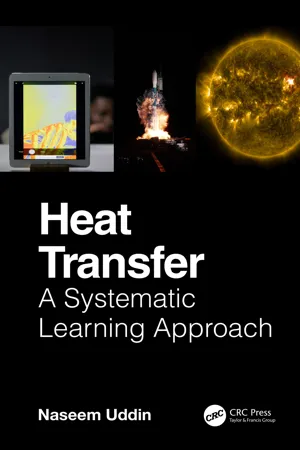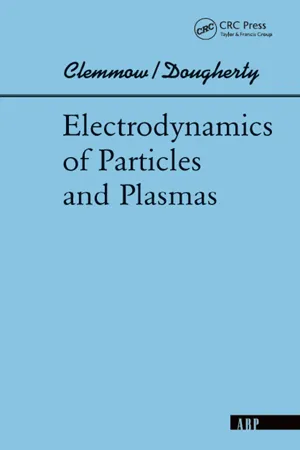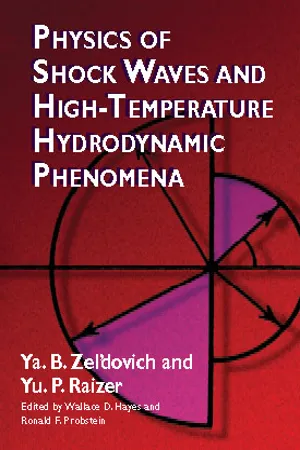Physics
Stefan Boltzmann Law
The Stefan-Boltzmann Law states that the total energy radiated per unit surface area of a black body is directly proportional to the fourth power of its absolute temperature. This law is expressed by the equation E = σT^4, where E is the energy radiated, σ is the Stefan-Boltzmann constant, and T is the absolute temperature. It is a fundamental principle in understanding the behavior of thermal radiation.
Written by Perlego with AI-assistance
Related key terms
Related key terms
1 of 4
Related key terms
1 of 3
10 Key excerpts on "Stefan Boltzmann Law"
- eBook - ePub
Heat Transfer 2
Radiative Transfer
- Michel Ledoux, Abdelkhalak El Hami(Authors)
- 2021(Publication Date)
- Wiley-ISTE(Publisher)
pdV”. The sign of the calculated work may be significant. Here, in terms of equality of two calculations of energy quantity, we can discard it.And by identification we find:[2.26]which is the starting point for many scientific publications. It is therefore important to know this expression when exploring the literature.NOTE.– Readers familiar with statistical thermodynamics will have recognized in the term the energy ratio of the photon to the Boltzmann term . This is not surprising, since Planck’s rationale was based exactly on a statistical calculation (Boltzmann was a pupil of Planck who contributed to this theory).2.3. Stefan–Boltzmann law
In the subject of radiation, the main laws have been expressed on an experimental basis, before being integrated in a synthetic theoretical vision based on Planck’s theory.2.3.1. Establishing the lawThe Stefan–Boltzmann law was posed experimentally through the work of Joseph Stefan in 1879 using Tyndall‘s experimental data. The theoretical foundations were posed in the context of thermodynamics by one of Stefan’s doctoral students, Ludwig Boltzmann (1844–1906), in 1884.We will establish it here as a result of the luminance data, or more precisely the emittance from a black body surface.The total emittance of a black body in all directions and across the whole (infinite) wavelength spectrum is calculated by integrating the total monochromatic emittance of λ = 0 to λ → ∞[2.27][2.28]This integral is transformed easily by carrying out a change of variable:[2.29][2.30]and:[2.31]Posing[2.32]We obtain[2.33]σ is a constant equal to:[2.34]The constant σ - eBook - ePub
Introduction to Quantum Mechanics 1
Thermal Radiation and Experimental Facts of the Quantization of Matter
- Ibrahima Sakho(Author)
- 2019(Publication Date)
- Wiley-ISTE(Publisher)
Joseph Stefan was an Austrian physicist. He is especially renowned for his work published in 1879 on the radiation of the black body in which he stated the law that bears his name. Based on this law, Stefan determined the Sun’s surface temperature (5430°C). Then his student Boltzmann offered a theoretical justification for the Stefan law. This is why this law is commonly known as the Stefan–Boltzmann law (for Boltzmann, see Box A.3).1.3.6. Wien’s laws, useful spectrumThe two Wien’s laws give the abscissa λmax of the wavelength and the ordinate of the maximum monochromatic exitance for each temperature T of the black body (Figure 1.8 ).Wien’s first lawThe wavelength λmax at an isotherm peak shifts toward short wavelengths when temperature T increases according to the law:[1.18]In this relation, σw designates the Wien constant: σW = 2.898 × 10−3 m · k.Isotherm curve of the black body at temperature TFigure 1.8.Useful spectrum (hatched part of the isotherm curve)Figure 1.9.Wien’s law [1.19] shows that the value of λmax shifts toward short wavelengths when the temperature T increases.Wien’s second lawThe ordinate of the maximum monochromatic exitance is proportional to the fifth power of temperature, which is:[1.19]In relation [1.19] , is expressed in W · m−3 (if the wavelength λmax is expressed in m) or in W · m−2 · µm−1 (if λmax is expressed in micrometers); the units of constant B depend on the unit of wavelength λmax .[1.20]Moreover, experience shows that when the wavelength of radiation is such that λ < 0.5 λmax , there is practically no more radiated energy (approximately 1%) [PER 11].Furthermore, there is practically no more radiated energy when λ > 4.5 λmax . By definition, the wavelength range 0.5 λmax < λ < 4.5 λmax is called the useful spectrum of the considered isotherm (hatched part in Figure 1.9 ).APPLICATION 1.4.–
Let us consider an isotherm at the surface temperature of the Sun, which is assimilated to a black body. Find the useful spectrum corresponding to T - eBook - ePub
Let There Be Light
The Story of Light from Atoms to Galaxies
- Alex Montwill, Ann Breslin(Authors)
- 2008(Publication Date)
- ICP(Publisher)
λ are power per unit area per unit wavelength interval.At a temperature below about 2000 K, only a small fraction of the power is emitted at wavelengths in the visible region.11.1.4 The Stefan–Boltzmann lawThe total power emitted, at all wavelength at a given temperature (M), is represented by the area under the corresponding curve:It is clear from Figure 11.2 that the area under each curve rises rapidly with an increase in temperature.Josef Stefan. Courtesy of Austrian Post.Josef Stefan (1835–1893) was the first to publish (in 1879) an empirical relation known as Stefan's law, which expressed the observation that the total energy emitted appeared to be proportional to the fourth power of the absolute temperature of the surface. About five years later Ludwig Boltzmann (1844–1906) derived the relation using thermodynamic arguments which is now known as the Stefan-Boltzmann law.Stefan-Boltzmann law: M = εσT4Ludwig Boltzmann. Courtesy of Austrian Post.11.1.5 Wien's displacement law; the spectral distributionAs the surface temperature rises, the peak of the spectrum moves towards shorter wavelengths (higher frequencies). This is in line with the common experience that as a lump of coal or an iron bar or a tungsten filament gets heated, it begins to glow. Not only does it become brighter, but the predominant colour of the light changes from deep red to bright yellow to ‘white-hot’. Experiment shows that the relationship between the temperature and the wavelength at the peak of the curve follows a simple relation known as Wien's displacement law, which states that the higher the temperature the lower the wavelength at which radiation is maximum. We can see this in Figure 11.2 - eBook - ePub
- Mario Bertolotti(Author)
- 2004(Publication Date)
- CRC Press(Publisher)
T and at this moment that radiation (which would be small with respect to that contained in the interior) would exit the hole as a sample of the characteristic radiation in the cavity.A little later, in 1865, J Tyndall (1820–1893) published the results of some measurements of the ability of a body heated at two different temperatures to emit radiation. He had heated a blackened platinum wire, that is not exactly a blackbody. However, albeit imperfect, the measurements were used in 1879 by the Austrian physicist Josef Stefan (1835–1893) to state an empirical law according to which the quantity of energy emitted per unit surface area by a hot body is proportional to the fourth power of its absolute temperature.The blackbody laws
Stefan’s law attracted the attention of his pupil, Ludwig Boltzmann (1844–1906) who, by utilizing the principles of thermodynamics and electromagnetism, in 1884, delivered its theoretical proof using also a relation between the radiation pressure and the second law of thermodynamics, discovered several years before by the Italian physicist Adolfo Bartoli (1851–1896).Ludwig Edward Boltzmann was born in Vienna during the night between Shrove Tuesday and Ash Wednesday, the son of a tax officer. Jokingly, he used to attribute his sudden temper changes between great happiness and deep depression to the fact he was born just at the death of a merry dance of Shrove Tuesday. He was a typical cyclothymiac, a short, robust man with curly hair; his girlfriend called him ‘sweet dear fatty’. After earning his doctorate in Vienna in 1866, working under the guidance of Stefan to construct the kinetic theory of gases, he became his assistant and at the suggestion of Stefan, at only 25, was appointed to the mathematical physics chair at the Graz University. - eBook - ePub
- Max Born(Author)
- 2013(Publication Date)
- Dover Publications(Publisher)
For light quanta, as we have shown above (p. 224), the second subsidiary condition (constancy of number of particles) drops out. Thus we find in the usual way orThe Bose-Einstein law of distribution for light quanta therefore runs (if we drop the index s)this gives for the energy densityThis is just Planck’s radiation formula, if we put β = 1/kT. The justification for this last step is given by thermodynamics; according to Boltzmann, S = k log W is to be regarded as the entropy, and it can then be shown (see Appendix XXXV , p. 459) that from the equation TdS = dQ we can infer that β = 1/kT (dQ is the increment of the heat content, or, at constant volume, of the energy content of the light quantum gas). From the Bose-Einstein statistics, therefore, Planck’s radiation law can be deduced in a way to which no objection can be taken.5. Einstein’s Theory of Gas Degeneration.After the brilliant success of the Bose-Einstein statistics with the fight quantum gas, it was a natural suggestion to try it in the kinetic theory of gases also, as a substitute for the Boltzmann statistics. The investigation, which was undertaken by Einstein (1925), is based on the hypothesis that the molecules of a gas are, like light quanta, indistinguishable from each other.The calculations run exactly as in the light quantum case, except that here a second subsidiary condition appears, on account of the conservation of the number of particles:The determination of the probability of a definite distribution n1 , n2 , . . . follows the same lines as before. The calculation of the most probable distribution leads now, owing to the presence of the second subsidiary condition, to the equationor, on dropping the suffix s,where again β = 1/kT (see Appendix XXXV , p. 459). Here the number g - eBook - ePub
Statistical Physics
A Probabilistic Approach
- Bernard H. Lavenda(Author)
- 2016(Publication Date)
- Dover Publications(Publisher)
So we conclude that Planck’s radiation law must be given by the original expression (2.17). In the Rayleigh–Jeans limit, it becomes (2.52), which must be equated with the Rayleigh–Jeans formula, which, as we recall, was obtained from purely classical considerations, i.e., equipartition of energy. Therefore, upon equating (2.29) with the asymptotic expression (2.52), we obtain in contrast to Einstein’s result. Hence, for the same reason that Einstein and Stern, in their 1913 paper, found it necessary to distinguish between the two proposed forms of Planck’s law, (2.17) and (2.53), we see here that the Einstein coefficients are not temperature independent, albeit, the temperature dependency is a weak one. We emphasize that of the two expressions for the radiation law, it is only the original expression (2.17) that is acceptable for black radiation, although it does not give the classical equipartition limit result. We will leave till §3.3.1 the demonstration that there is no need to decompose the rates into temperature dependent and temperature independent parts. It is precisely the second law that will provide automatically the correct temperature dependency as well as the stability of the radiation process. We can avoid the Einstein coefficients entirely by introducing some information about the electrons which are absorbing and emitting radiation. Surely, Einstein had no knowledge of the exclusion principle, and much less knew of Fermi–Dirac statistics, so his derivation cannot be undermined by facts which were only to be learned afterward. Nevertheless, it is an interesting exercise to show that one form of statistics implies the other. Let φ m be the probability (a proper fraction!) that an electron is in state m and 1 – φ m that it is not. The probability that an electron will make a transition n → m is the product φ n (1 – φ m) - Anne M. Hofmeister(Author)
- 2018(Publication Date)
- Elsevier(Publisher)
c , in dilute gas).Figure 8.1 Schematic of how blackbody emissions are produced and measured, with a comparison to spectroscopic measurements. Left, thermal and visible emissions from a source (candle) travel outwards linearly (arrows). For a point source, the emissions are radial, defining a spherical front at some time t 1 , but for realistic shapes, the sphere is incomplete (dashed arc). The cone illustrates that for any source, the radiation defines part of a sphere, and so the heat emitted is defined as energy per area per steradian (medium gray end of cone, labeled flux). Stefan’s experiment measures the heat being transferred at some given distance over a defined area. Right, interaction of light from some source with molecules in the air. At some time t 2 , the light crosses the gas, interacting with some molecules when certain conditions are met. Some molecules uptake heat, for example, in a vibrational transition, which can be described as the excited molecules having a higher temperature. Spectroscopic measurements record the uptake of the energy as a loss from the impinging flux. At some later time, the excited molecule releases the excess and returns to the equilibrium state of the surrounding air.Planck’s first derivation in 1900 of Eq. (8.1) did not specify the constants, did not invoke energy quantization, and did not use statistical mechanics, as he was a critic of Boltzmann, which he much later regretted (~1942, see Kangro, 1976 ). Planck portrayed his second attempt in 1901, which included the constants, as a mathematical construction (Kragh, 2000 ). The quantization interpretation came later. Historic data motivating his efforts are shown in Fig. 8.2 . Irrespective of the assumptions made and the mathematical manipulations used, the form of Eq. (8.1)- eBook - ePub
Heat Transfer
A Systematic Learning Approach
- Naseem Uddin(Author)
- 2024(Publication Date)
- CRC Press(Publisher)
have ζ 3 [ exp (ζ) − 1 ] = ζ 3 [ e − ζ + e − 2 ζ + e − 3 ζ + ⋯ ] Integrating with up till 6th term we have ∫ 0 ∞ ζ 3 [ exp (ζ) − 1 ] d ζ = 6.486741204 and the total emissive power of a blackbody. is E b = c 1 T 4 c 2 4 (6.486741204) = 5.67 410 × 10 − 8 T 4 E b = σ T 4 The constant σ = 5.67410 × 10 − 8 W / m 2 K 4 is called Stefan-Boltzmann constant. In US customary units, the value of this constant is 1.71344 ×10 -9 Btu ⋅ hr -1 ⋅ft -2 ⋅ ∘ R -4. The total intensity of the emitted radiation from blackbody is I b = E b / π Pioneers of Heat Transfer Josef Stefan (1835–1893) was professor at the University of Vienna and in 1879, he inferred from some of his experiments that blackbody emission is proportional to temperature to the fourth power. Previously, Ludwig Erhard Boltzmann (1844–1906) in 1889 derived the fourth-power law purely from thermodynamic relations. Close to our planet the biggest source of thermal radiation is our star - the sun. Solar energy coming to Earth varies over the year as the Earth orbait around sun is elliptical. The maximum irradiation received from sun is about 1412 W/m 2 in early January, and a minimum of about 1321 W/m 2 happens in early July. Example 13.1 Solar energy received by the earth's atmosphere, also called the solar constant is measured to be around 1367 W/m 2. Estimate the solar constant on Jupiter? The distance from earth to sun is 147.48 million km, and distance from sun to Jupiter is 740.85 million km. Solution The radiation from sun surface spreading spherically and reaching Earth is q s u n − e a r t h = Q A s = σ T s u n 4 4 π R s e 2 where R s e is the distance from sun to earth. The radiation from sun surface spreading spherically and reaching Jupiter is q s u n − J u p i t e r = Q A s = σ T s u n 4 4 π R s j 2 where R s j is the distance from sun to Jupiter. Taking the ratio of two equations we. have q s u n − J u p i t e r q s u n − e a r t h = R s e 2 R s j 2 = (R s e R s j) 2 According to give data we - eBook - ePub
- Phillip C Clemmow(Author)
- 2018(Publication Date)
- CRC Press(Publisher)
λ is different for the two species. In particular the boundary layer between a uniform magnetic field and a field-free hot plasma can be discussed in this way, though the plasma has to be slightly anisotropic. (See Lam (1967) for details.)REFERENCES Liouville’s theorem and its role in statistical mechanics are discussed in many standard texts on the subject, for instanceJ. E. MAYER and M. G. MAYER , Statistical Mechanics, Wiley (1940).Boltzmann collected his researches on kinetic theory into a treatise which has recently been republished in an English translationL. BOLTZMANN , Lectures On Gas Theory, translated, and with an Introduction, by S. G. Brush, University of California (1964).The basic properties of the Boltzmann equation are given in detail in the classic textS. CHAPMAN and T. G. COWLING , The Mathematical Theory of Non-Uniform Gases, 2nd edn, Cambridge University Press (1952).For Lagrange’s method in partial differential equationsR. COURANT , Methods of Mathematical Physics, vol. 2, p. 62, Interscience (1962).For the relativistic Boltzmann equation, and a relativistic counterpart of Problem 7, seeO. BUNEMAN , in Plasma Physics, Chapter 7, ed. J. E. Drummond, McGraw-Hill (1961).For details of the solution suggested in Problem 9, seeS. H. LAM , Phys. Fluids, 10, 2454 (1967).For the application of Jeans’s theorem to stellar dynamics, seeS. CHANDRASEKHAR , Principles of Stellar Dynamics, p. 85. Dover Publications (1960).For the Saha equationJ. A. FAY , Molecular Thermodynamics, Addison-Wesley (1965).* This is the negative of the stress tensor as usually defined in fluid mechanics or elasticity; it is, however, the quantity generally used in kinetic theory.* This step includes a factor1 2arising from the fact that the mutual potential energy of a set of particles is counted twice if one simply sums the energies of the particles: but a further factor 2 as there are two species each with density N0 - Ya. B. Zel’dovich, Yu. P. Raizer, Yu. P. Raizer(Authors)
- 2012(Publication Date)
- Dover Publications(Publisher)
kT in the Wien region.The correct description of the equilibrium between the emission and absorption, leading to the Planck distribution function, is obtained only by taking into account the phenomenon of induced emission. In our example of an atomic system with two energy levels we obtainwhich gives us the Planck equation for the intensity I vp (with the const above equal to 2hv3 /c2 ).The above discussion shows that the induced emission becomes negligible in comparison with the spontaneous emission under equilibrium conditions as hν /kt → ∞, that is, in the Wien region of the spectrum. This is directly evident from (2.19), if we note that at equilibrium and in the limit as hν /kT → ∞,On the other hand, in the Rayleigh-Jeans region of the spectrum, where h ν kT , the relative role of the induced emission becomes dominant; in (2.19) we findso that the ratio of probabilities of induced and spontaneous emissions is equal to kT /hν 1.It should be noted that in the case when the radiation field is not in equilibrium, the above considerations about the relative roles of spontaneous and induced emissions are generally invalid. The induced emission is proportional to the actual radiation intensity, which in the absence of equilibrium can be arbitrary.§4a. Induced emission of radiation in the classical and quantum theories and the laser effect
In recent years there has been a great deal of attention paid to the phenomenon of induced emission of radiation, because of the fact that it serves as the basis of laser and maser operation. In order to explain this phenomenon in physical terms we shall first describe it from the classical point of view. As is well known, in the classical model of a radiating atom the atom is represented with an elastically bound electron, that is, as a harmonic oscillator. Let the electric field of a light wave act on this oscillator as an inducing force, with the wave frequency the same as the natural frequency of the oscillator. If the oscillator was initially at rest at t = 0, then under the action of the field it will go into resonant oscillations, with the amplitude increasing as t and the energy as t 2
Index pages curate the most relevant extracts from our library of academic textbooks. They’ve been created using an in-house natural language model (NLM), each adding context and meaning to key research topics.
Explore more topic indexes
Explore more topic indexes
1 of 6
Explore more topic indexes
1 of 4
